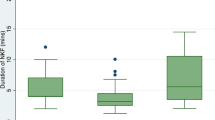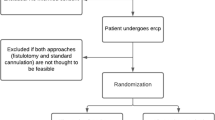Abstract
Background
Suprapapillary needleknife fistulotomy is performed when standard biliary cannulation methods have failed. However, its role is controversial, with conflicting reports on its use. This study aimed to determine the efficacy and safety of needleknife fistulotomy after failure of conventional cannulation techniques.
Methods
All patients who underwent needleknife fistulotomy were identified from a single tertiary referral center database prospectively maintained from 1997 to 2007.
Results
A total of 2,603 patients underwent endoscopic retrograde cholangiopancreatography (ERCP) over the 10-year period. Fistulotomy was performed for 352 patients (13.5%), with 317 of these patients (90.1%) experiencing successful biliary cannulation. With the use of fistulotomy, the total cannulation success rate increased from 79.0 to 91.2% (P < 0.0001). Endoscopic management of choledocholithiasis and hepatobiliary malignancy increased from 48.9 to 55.1% (P < 0.001), and from 12.0 to 16.0% (P < 0.001) for all cases. The complication rate was significantly higher for the patients who underwent fistulotomy than for those who did not (4.8% vs. 2.1%; P < 0.001), which can be explained by a higher rate of mild bleeding in the fistulotomy group. However, no significant difference in pancreatitis or perforation between the two groups was observed. In addition, no fatalities occurred after fistulotomy.
Conclusion
Suprapapillary needleknife fistulotomy is an effective method for accessing the biliary system after failed standard cannulation. Despite a higher rate of mild bleeding, fistulotomy was not associated with an increased risk of serious complications.


Similar content being viewed by others
References
Mavrogiannis C, Liatsos C, Romanos A, Petoumenos C, Nakos A, Karvountzis G (1999) Needleknife fistulotomy versus needleknife precut papillotomy for the treatment of common bile duct stones. Gastrointest Endosc 50:334–339
Boender J, Nix GA, de Ridder MA, van Blankenstein M, Schütte HE, Dees J, Wilson JH (1994) Endoscopic papillotomy for common bile duct stones: factors influencing the complication rate. Endoscopy 26:209–216
Cotton PB (1989) Precut papillotomy: a risky technique for experts only. Gastrointest Endosc 35:578–579
Siegel JH (1980) Precut papillotomy: a method to improve success of ERCP and papillotomy. Endoscopy 12:130–133
Maydeo A, Borkar D (2003) Techniques of selective cannulation and sphincterotomy. Endoscopy 35:S19–S23
de Weerth A, Seitz U, Zhong Y, Groth S, Omar S, Papageorgiou C, Bohnacker S, Seewald S, Seifert H, Binmoeller KF, Thonke F, Soehendra N (2006) Primary precutting versus conventional over-the-wire sphincterotomy for bile duct access: a prospective randomized study. Endoscopy 38:1235–1240
Abu-Hamda EM, Baron TH, Simmons DT, Petersen BT (2005) A retrospective comparison of outcomes using three different precut needle knife techniques for biliary cannulation. J Clin Gastroenterol 39:717–721
Cotton PB, Lehman G, Vennes J, Geenen JE, Russell RC, Meyers WC, Liguory C, Nickl N (1991) Endoscopic sphincterotomy complications and their management: an attempt at consensus. Gastrointest Endosc 37:383–393
Huibregtse K, Katon RM, Tytgat GN (1986) Precut papillotomy via fine needleknife papillotome: a safe and effective technique. Gastrointest Endosc 32:403–405
Zhou PH, Yao LQ, Xu MD, Zhong YS, Gao WD, He GJ, Zhang YQ, Chen WF, Qin XY (2006) Application of needleknife in difficult biliary cannulation for endoscopic retrograde cholangiopancreatography. Hepatobiliary Pancreat Dis Int 5:590–594
Kaffes AJ, Sriram PV, Rao GV, Santosh D, Reddy DN (2005) Early institution of precutting for difficult biliary cannulation: a prospective study comparing conventional vs a modified technique. Gastrointest Endosc 62:669–674
Espinel Diez J, Vivas Alegre S, Muñoz Núñez F, Domínguez Carbajo A, Villanueva Pavón R, Jorquera Plaza F, Olcoz Goñi JL (2005) Needleknife sphincterotomy for biliary access: a prospective study. Gastroenterol Hepatol 28:369–374
Ahmad I, Khan AA, Alam A, Butt AK, Shafqat F, Sarwar S (2005) Precut papillotomy outcome. J Coll Physicians Surg Pak 15:701–703
Khatibian M, Sotoudehmanesh R, Ali-Asgari A, Movahedi Z, Kolahdoozan S (2008) Needleknife fistulotomy versus standard method for cannulation of common bile duct: a randomized controlled trial. Arch Iran Med 11:16–20
Freeman M, DiSario J, Nelson D, Fennerty M, Lee J, Bjorkman D, Overby C, Aas J, Ryan M, Bochna G, Shaw M, Snady H, Erickson R, Moore J, Roel J (2001) Risk factors for post-ERCP pancreatitis: a prospective, multicenter study. Gastrointest Endosc 54:425–434
Bruins Slot W, Schoeman MN, Disario JA, Wolters F, Tytgat GN, Huibregtse K (1996) Needleknife sphincterotomy as a precut procedure: a retrospective evaluation of efficacy and complications. Endoscopy 28:334–339
Katsinelos P, Mimidis K, Paroutoglou G, Christodoulou K, Pilpilidis I, Katsiba D, Kalomenopoulou M, Papagiannis A, Tsolkas P, Kapitsinis I, Xiarchos P, Beltsis A, Eugenidis N (2004) Needleknife papillotomy: a safe and effective technique in experienced hands. Hepatogastroenterology 51:349–352
Hogan WJ, Geenen JE (1988) Biliary dyskinesia. Endoscopy 20(Suppl 1):179–183
Disclosures
Fergal Donnellan, Faisal Zeb, Garry Courtney, and Abdur Rahman Aftab have no conflicts of interest or financial ties to disclose.
Author information
Authors and Affiliations
Corresponding author
Rights and permissions
About this article
Cite this article
Donnellan, F., Zeb, F., Courtney, G. et al. Suprapapillary needleknife fistulotomy: a safe and effective method for accessing the biliary system. Surg Endosc 24, 1937–1940 (2010). https://doi.org/10.1007/s00464-010-0881-9
Received:
Accepted:
Published:
Issue Date:
DOI: https://doi.org/10.1007/s00464-010-0881-9




